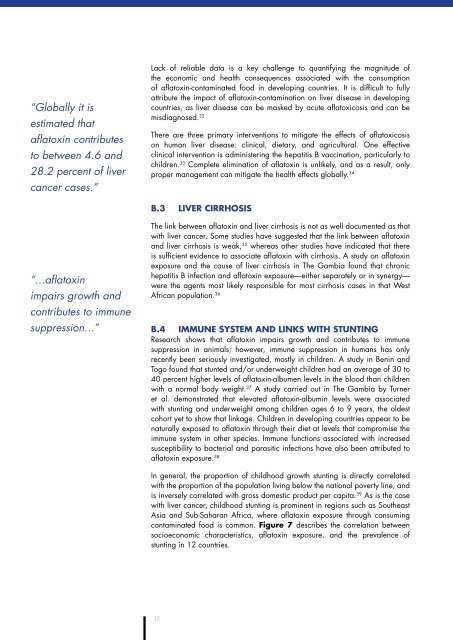Aflatoxin: A Synthesis of the Research in Health, Agriculture and Trade
Aflatoxin: A Synthesis of the Research in Health, Agriculture and Trade
Aflatoxin: A Synthesis of the Research in Health, Agriculture and Trade
Create successful ePaper yourself
Turn your PDF publications into a flip-book with our unique Google optimized e-Paper software.
“Globally it is<br />
estimated that<br />
aflatox<strong>in</strong> contributes<br />
to between 4.6 <strong>and</strong><br />
28.2 percent <strong>of</strong> liver<br />
cancer cases.”<br />
“...aflatox<strong>in</strong><br />
impairs growth <strong>and</strong><br />
contributes to immune<br />
suppression...”<br />
lack <strong>of</strong> reliable data is a key challenge to quantify<strong>in</strong>g <strong>the</strong> magnitude <strong>of</strong><br />
<strong>the</strong> economic <strong>and</strong> health consequences associated with <strong>the</strong> consumption<br />
<strong>of</strong> aflatox<strong>in</strong>-contam<strong>in</strong>ated food <strong>in</strong> develop<strong>in</strong>g countries. it is difficult to fully<br />
attribute <strong>the</strong> impact <strong>of</strong> aflatox<strong>in</strong>-contam<strong>in</strong>ation on liver disease <strong>in</strong> develop<strong>in</strong>g<br />
countries, as liver disease can be masked by acute aflatoxicosis <strong>and</strong> can be<br />
misdiagnosed. 32<br />
<strong>the</strong>re are three primary <strong>in</strong>terventions to mitigate <strong>the</strong> effects <strong>of</strong> aflatoxicosis<br />
on human liver disease: cl<strong>in</strong>ical, dietary, <strong>and</strong> agricultural. one effective<br />
cl<strong>in</strong>ical <strong>in</strong>tervention is adm<strong>in</strong>ister<strong>in</strong>g <strong>the</strong> hepatitis B vacc<strong>in</strong>ation, particularly to<br />
children. 33 complete elim<strong>in</strong>ation <strong>of</strong> aflatox<strong>in</strong> is unlikely, <strong>and</strong> as a result, only<br />
proper management can mitigate <strong>the</strong> health effects globally. 34<br />
B.3 liver cirrHoSiS<br />
<strong>the</strong> l<strong>in</strong>k between aflatox<strong>in</strong> <strong>and</strong> liver cirrhosis is not as well documented as that<br />
with liver cancer. Some studies have suggested that <strong>the</strong> l<strong>in</strong>k between aflatox<strong>in</strong><br />
<strong>and</strong> liver cirrhosis is weak, 35 whereas o<strong>the</strong>r studies have <strong>in</strong>dicated that <strong>the</strong>re<br />
is sufficient evidence to associate aflatox<strong>in</strong> with cirrhosis. A study on aflatox<strong>in</strong><br />
exposure <strong>and</strong> <strong>the</strong> cause <strong>of</strong> liver cirrhosis <strong>in</strong> <strong>the</strong> Gambia found that chronic<br />
hepatitis B <strong>in</strong>fection <strong>and</strong> aflatox<strong>in</strong> exposure—ei<strong>the</strong>r separately or <strong>in</strong> synergy—<br />
were <strong>the</strong> agents most likely responsible for most cirrhosis cases <strong>in</strong> that West<br />
African population. 36<br />
B.4 iMMune SySteM And l<strong>in</strong>kS witH Stunt<strong>in</strong>G<br />
<strong>Research</strong> shows that aflatox<strong>in</strong> impairs growth <strong>and</strong> contributes to immune<br />
suppression <strong>in</strong> animals; however, immune suppression <strong>in</strong> humans has only<br />
recently been seriously <strong>in</strong>vestigated, mostly <strong>in</strong> children. A study <strong>in</strong> Ben<strong>in</strong> <strong>and</strong><br />
togo found that stunted <strong>and</strong>/or underweight children had an average <strong>of</strong> 30 to<br />
40 percent higher levels <strong>of</strong> aflatox<strong>in</strong>-albumen levels <strong>in</strong> <strong>the</strong> blood than children<br />
with a normal body weight. 37 A study carried out <strong>in</strong> <strong>the</strong> Gambia by turner<br />
et al. demonstrated that elevated aflatox<strong>in</strong>-album<strong>in</strong> levels were associated<br />
with stunt<strong>in</strong>g <strong>and</strong> underweight among children ages 6 to 9 years, <strong>the</strong> oldest<br />
cohort yet to show that l<strong>in</strong>kage. children <strong>in</strong> develop<strong>in</strong>g countries appear to be<br />
naturally exposed to aflatox<strong>in</strong> through <strong>the</strong>ir diet at levels that compromise <strong>the</strong><br />
immune system <strong>in</strong> o<strong>the</strong>r species. immune functions associated with <strong>in</strong>creased<br />
susceptibility to bacterial <strong>and</strong> parasitic <strong>in</strong>fections have also been attributed to<br />
aflatox<strong>in</strong> exposure. 38<br />
<strong>in</strong> general, <strong>the</strong> proportion <strong>of</strong> childhood growth stunt<strong>in</strong>g is directly correlated<br />
with <strong>the</strong> proportion <strong>of</strong> <strong>the</strong> population liv<strong>in</strong>g below <strong>the</strong> national poverty l<strong>in</strong>e, <strong>and</strong><br />
is <strong>in</strong>versely correlated with gross domestic product per capita. 39 As is <strong>the</strong> case<br />
with liver cancer, childhood stunt<strong>in</strong>g is prom<strong>in</strong>ent <strong>in</strong> regions such as Sou<strong>the</strong>ast<br />
Asia <strong>and</strong> Sub-Saharan Africa, where aflatox<strong>in</strong> exposure through consum<strong>in</strong>g<br />
contam<strong>in</strong>ated food is common. figure 7 describes <strong>the</strong> correlation between<br />
socioeconomic characteristics, aflatox<strong>in</strong> exposure, <strong>and</strong> <strong>the</strong> prevalence <strong>of</strong><br />
stunt<strong>in</strong>g <strong>in</strong> 12 countries.<br />
15


